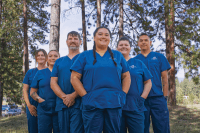Understanding the process helps ensure a successful project.
The final doctor of nursing practice (DNP) project provides students with the opportunity to systematically translate the best current evidence into practice. However, variability in how projects are implemented exists among programs. In response, the American Association of Critical Care Nurses (AACN) commissioned white papers from two internal task forces: the Implementation Task Force (ITF) and the Advanced Practice Registered Nurse Clinical Training Task Force. The ITF’s white paper, The Doctor of Nursing Practice: Current Issues and Clarifying Recommendations, describes and clarifies the characteristics of DNP graduate scholarship (including the DNP project), efficient resource use, program length, curriculum considerations, practice experiences, and collaborative partnership guidelines. The Advanced Practice Registered Nurse Clinical Task Force white paper, Re-envisioning the Clinical Education of Advanced Practice Registered Nurses, explores how APRN education can adapt to include more simulation opportunities, academic-practice partnerships, competency-based assessments, and nontraditional APRN clinical education models, such as technology or informatics. However, the AACN doesn’t make specific recommendations with regard to the final DNP project, pointing instead to the DNP Essentials to explain the project’s scope and depth.
This article discusses the issue of project variability, then explores DNP project fundamentals to help eliminate ambiguity and confusion and broaden students’ understanding of the project’s significance. Before initiating a DNP project, several key elements—mentoring, time management, organizational and academic support, potential institutional review board approval, and planning for dissemination—must be in place. (See 8 steps to completion.)
8 steps to completion
Students should take these eight steps to complete their doctor of nursing practice (DNP) projects.
- Identify and obtain approval for the area of interest.
- Write a proposal.
- Create a project timeline.
- Acquire institutional review board approval (if needed).
- Implement project.
- Write final report.
- Present an oral presentation.
- Disseminate the project.
Source: Anderson et al. 2015.
DNP project variability
With the increased volume of new programs and growing interest in the DNP degree, the profession must clarify the scope of the final project, including implementation, impact on system and practice outcomes, extent of collaborative efforts, dissemination, and degree of faculty mentorship and oversight. Some universities require students to complete a practice improvement project over the span of a course, whereas others require students to initiate an evidence-based practice (EBP) innovation project when they begin the program and continue it through the final semester.
Despite projects’ various forms, many elements—including planning, implementation, evaluation, and sustainability—must be consistent across programs. Without concrete guidelines, programs have employed several interpretations, including portfolios, case studies, systematic reviews, and writing projects. (See Project dissemination variability.)
Project dissemination variability
Several doctor of nursing practice (DNP) project types are included in the DNP Essentials. The table compares the American Association of Colleges of Nursing’s (AACN’s) white paper recommendations and AACN DNP Tool Kit with regard to dissemination.
| DNP project type | White paper recommendations (not all recommendations have been adopted in the DNP Essentials) | DNP Tool Kit (combines DNP Essentials and white paper) |
| Practice portfolio | · A student’s portfolio isn’t considered a DNP project or a form of dissemination. It’s a tool to document and evaluate professional development and learning. · At a minimum, an executive summary or a written report that’s disseminated or shared beyond the academic setting is recommended for DNP project outcomes. | · A student’s portfolio isn’t considered a DNP project or a form of dissemination. It’s a tool to document and evaluate professional development and learning. · At a minimum, an executive summary or a written report that’s disseminated or shared beyond the academic setting is recommended for DNP project outcomes. |
| Manuscript submitted for publication | · Publication in a peer-reviewed print or on-line journal is recommended. Individual faculty or a faculty committee should carefully evaluate manuscripts for possible publication and select those most appropriate for submission. · Publication in a non-refereed lay publication. | · Publication in a peer-reviewed print or on-line journal is recommended. Individual faculty or a faculty committee should carefully evaluate manuscripts for possible publication and select those most appropriate for submission. · Publication in a non-refereed lay publication. |
| Systematic review | · An integrative and systematic review alone isn’t considered a DNP project and doesn’t provide opportunities for students to develop and integrate scholarship into their practice. | · Not addressed |
| Research utilization project | · Not addressed in recommendations | · Not addressed |
| Practice topic dissemination | · Dissemination is required for each project and should include a product that describes the project’s purpose, planning, implementation, and evaluation components of the project. | · Not addressed |
| Substantial involvement in a larger endeavor or other practice project | · Poster and podium presentations · Presentation of a written or verbal executive summary to stakeholders and/or the practice site/organization leadership · Development of a webinar presentation or video (e.g. via YouTube or other public site) · Oral presentation to the public-at-large · Development and presentation of a digital poster, a grand rounds presentation, and/or a PowerPoint presentation |
· Poster and podium presentations · Presentation of a written or verbal executive summary to stakeholders and/or the practice site/organization leadership) · Development of a webinar presentation or video (e.g. via YouTube or other public site) · Oral presentation to the public-at-large · Development and presentation of a digital poster, a grand rounds presentation, and/or a PowerPoint presentation · Financial and production resources to assist students |
| Practice change initiative: · pilot study · program evaluation · quality improvement project · evaluation of a new practice model · consulting project · integrated critical literature review | Project should · focus on a change that impacts healthcare outcomes either through direct or indirect care · have a systems or population/aggregate focus and demonstrate implementation in the appropriate arena or area of practice · include a realistic (financial, systems, political) plan for sustainability · include an evaluation of processes and outcomes (formative or summative) · be designed so processes and outcomes will be evaluated to guide practice and policy · provide a foundation for future practice scholarship. | · Not addressed |
Reasons for variability include:
- lack of faculty familiarity with quality improvement (QI) and EBP methods
- strain on faculty capacity and time commitment for project completion
- lack of faculty expertise in DNP education
- inability to find clinical sites that allow students to implement projects
- lack of DNP faculty resulting in programs led by PhD faculty
- lack of graduate-level writing skills
- differing student education levels (for example, BSN-DNP, MSN-DNP)
- time constraints within the iterative process requiring multiple revisions of written work.
Although some program variability is expected, concern about the lack of adherence to the DNP Essentials exists. In response, the AACN is committed to enhancing program congruency. To ensure consistency, post-master’s and post-baccalaureate DNP students (who begin their doctoral programs with different education and practice backgrounds) should graduate with the same comprehensive skill set as described in the DNP Essentials.
Project fundamentals
The DNP project, previously called the capstone project or the scholarly project, should demonstrate translation of acquired knowledge into clinical practice and exhibit the student’s growth in clinical knowledge, expertise, and use of the DNP Essentials and DNP Tool Kit. (See DNP Essentials and Tool Kit.)
DNP Essentials and Tool Kit
The American Association of Colleges of Nursing’s (AACN’s) eight DNP program essentials prepare nurse leaders for advanced practice.
- Scientific underpinnings for practice
- Organizational and systems leadership for quality improvement and systems thinking
- Clinical scholarship and analytical methods for evidence-based practice
- Information systems/technology and patient care technology for the improvement and transformation of healthcare
- Healthcare policy for advocacy in healthcare
- Interprofessional collaboration for improving patient and population health outcomes
- Clinical prevention and population health for improving the nation’s health
- Advanced nursing practice
DNP Tool Kit
The DNP Tool Kit, which continues to evolve, provides schools with the resources for formatting a DNP program. It combines information from the DNP Essentials and recommendations from the AACN DNP white paper to provide templates, exemplars, frequently asked questions, and other resources.
Projects can focus on QI, executive outcomes management, or an EBP change initiative aimed at strengthening healthcare. (See DNP project examples.)
Project examples
The following are examples of doctor of nursing practice (DNP) projects completed by the authors when they were DNP students.
Quality improvement projects
- After evaluating evidence-based practices for type 2 diabetic foot management, the student developed a new standardized protocol for staff education and patient care practices for foot care assessment and management.
- The student reinforced nursing education as a means to overcoming adherence barriers to an evidence-based sedation protocol for improved ICU outcomes.
Evidence-based practice projects
- The DNP student used an evidence-based survey tool to measure student anxiety when caring for dying patients. Based on the results, an education module was developed to help students manage their stress.
- To decrease nonurgent use of the emergency department and increase fever knowledge, the student created an educational program for caregivers of pediatric patients.
Guideline development and improvement project
- After a systematic evidence search, the student developed a neonatal abstinence syndrome treatment guideline to standardize care and reduce treatment duration, symptom severity, length of hospitalization, and costs.
While working on their projects, students learn to build strong, collaborative partnerships with stakeholders and mentors.
DNP programs throughout the United States require students to conduct various types of projects, which contributes to ongoing confusion about DNP preparation and role. However, all projects should reflect the DNP Essentials in a single, cumulative work that evolves as the student progresses through the program. In addition, this scholarly synthesis should serve as a platform for future scholarship after graduation.
According to the AACN DNP Tool Kit, all projects should:
- focus on a change that impacts the outcome of healthcare through direct or indirect care
- have a systems (micro-, meso-, or macro-level) or population/aggregate focus
- demonstrate implementation in the appropriate practice area
- include a plan for sustainability (it should take into account financial, systems, or political realities, not only theoretical abstractions)
- include an evaluation of processes and outcomes (formative or summative).
Frequently, a project is the outcome of a student’s identified need for improvement in clinical practice or patient outcomes guided by the spirit of inquiry. The project results are a compendium of graduate education immersed in nursing leadership, education, health policy, or clinical practice.
Dissemination
All DNP projects should emphasize positive change that advances quality outcomes, attention to systems thinking, strategies for sustainability with an appraisal of processes and outcomes, and a structure for future practice. The expectation is that DNP-prepared nurses will contribute to the body of knowledge in nursing practice by sharing their work with others so that they can apply it to their practice roles. Platforms for dissemination include social media, peer-reviewed journals, presentations, professional conferences, brochures, posters, policy briefs, organizational team meetings, media interviews, academia, and press releases. Many programs require students to summarize their projects for publication in a peer-reviewed journal.
The final requirement of the DNP project is a student’s presentation before their institution’s doctoral panel. In this venue, students deliver elemental details about their project’s processes and impact, including purpose, evidence synthesis, project design, data analysis, frameworks, and dissemination.
Be a trailblazer
DNP students’ final projects reflect the culmination of their educational journey and prepare them to share their work with others to benefit patients, the healthcare system, and the nursing profession. The result is a body of information that bridges the gap between research theory and clinical practice. As trailblazers, DNP-prepared nurses can empower other professionals to improve patient outcomes and achieve benchmarks for practice change supported by collaborative endeavors.
The following authors are DNP graduates from the University of Texas at Tyler in Tyler: Barbara Chapman is a family NP with the INTUNE Mobile Unit and assistant clinical professor in the school of nursing at The University of Texas at Tyler. Chiquesha Davis is department head of post-licensure programs, graduate programs, and assistant professor at Tarleton State University in Stephenville, Texas. Sonya Grigsby is a critical care NP at CHRISTUS Mother Frances Hospital in Tyler, adjunct nursing faculty at University of Texas at Tyler, and locum NP at OSF St. Francis Medical Center in Peoria, Illinois. Cyndi B. Kelley is a nurse manager in the special care nursery and chair of the doctoral collaboration council at Texas Health Presbyterian Hospital of Dallas and adjunct faculty in the ADN-to-BSN program at Grand Canyon University in Phoenix, Arizona. Rebecca Shipley is a family NP at CHRISTUS Trinity Mother Frances Health System. Christian Garrett is a DNP student at the University of Texas at Tyler, a family NP at CHRISTUS Trinity Mother Frances Hospital, and an adjunct professor in the school of nursing at The University of Texas at Tyler.
References
Alexander S. Scholarship in clinical practice: An update on recommendations for doctor of nursing practice programs. Clin Nurse Spec. 2016;30(1):58-61. doi:10.1097/NUR.0000000000000177
American Association of Colleges of Nursing. The doctor of nursing practice (DNP) tool kit. aacnnursing.org/DNP/Tool-Kit
American Association of Colleges of Nursing. The Doctor of Nursing Practice: Current Issues and Clarifying Recommendations. August 2015. aacnnursing.org/Portals/42/DNP/DNP-Implementation.pdf
Anderson BA, Knestrick JM, Barroso R. DNP Capstone Projects: Exemplars of Excellence in Practice. New York, NY: Springer Publishing Company; 2014.
Bednash G, Breslin ET, Kirschling JM, Rosseter RJ. PhD or DNP: Planning for doctoral nursing education. Nurs Sci Q. 2014;27(4):296-301. doi:10.1177/0894318414546415
Broome ME, Riner ME, Allam ES. Scholarly publication practices of doctor of nursing practice-prepared nurses. J Nurs Educ. 2013;52(8):429-34. doi:10.3928/01484834-20130718-02
Brown MA, Crabtree K. The development of practice scholarship in DNP programs: A paradigm shift. J Prof Nurs. 2013;29(6):330-7. doi:10.1016/j.profnurs.2013.08.003
Dols JD, Hernández C, Miles H. The DNP project: Quandaries for nursing scholars. Nurs Outlook. 2017;65(1):84-93. doi:10.1016/j.outlook.2016.07.009
Dreher HM, Glasgow MES. DNP Role Development for Doctoral Advanced Nursing Practice. 2nd ed. New York, NY: Springer Publishing Company; 2017.
Grigsby S, Chapman B, Kelley CB, et al. DNP and PhD: Complementary roles. Am Nurse Today. 2018;13(7):8-13.
Holly C. Scholarly Inquiry and the DNP Capstone. New York, NY: Springer Publishing Company; 2014.
Moran KJ, Burson R, Conrad D. The Doctor of Nursing Practice Project: A Framework for Success. Burlington, MA: Jones & Bartlett Learning; 2019.
Murphy MP, Staffileno BA, Carlson E. Collaboration among DNP- and PhD-prepared nurses: Opportunity to drive positive change. J Prof Nurs. 2015;31(5):388-94. doi:10.1016/j.profnurs.2015.03.001
Pandi-Perumal SR, Akhter S, Zizi F, et al. Project stakeholder management in the clinical research environment: How to do it right. Front Psychiatry. 2015;6(71). doi:10.3389/fpsyt.2015.00071
Shipley R, Chapman B, Davis C, et al. (2019). DNPs: Healthcare change agents. Am Nurse Today. 2019;14(7):16-8.
White KA, Hitzler ET, Anderson KM, et al. Essential knowledge, skills, & attitudes of mentors and mentees for successful DNP scholarly projects. Nurse Educ Today. 2018;71:107-10. doi:10.1016/j.nedt.2018.09.015
Zaccagnini ME, White KW. The Doctor of Nursing Practice Essentials. 3rd ed. Burlington, MA: Jones & Bartlett Learning; 2017.


















